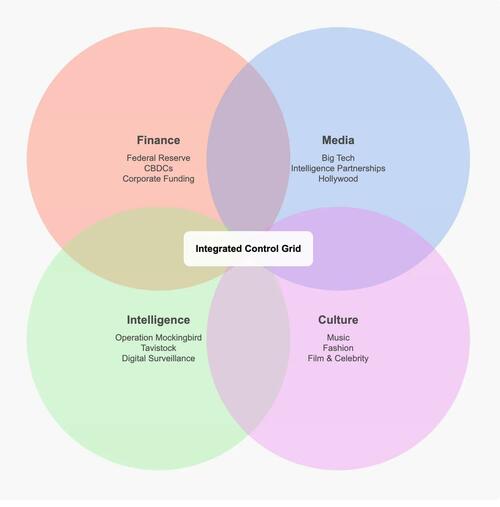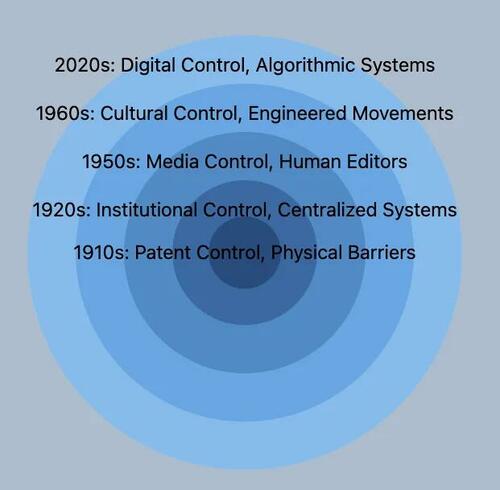
Engineering Reality: A Century Of Cultural Control, Part III – The Algorithmic Age
Authored by Joshua Stylman via substack,
A Century of Cultural Control From Edison’s Monopolies to Algorithmic Manipulation
Author’s Note: For years, I understood advertising was designed to manipulate behavior. As someone who studied the mechanics of marketing, I considered myself an educated consumer who could navigate rational market choices. What I didn’t grasp was how this same psychological architecture shaped every aspect of our cultural landscape. This investigation began as curiosity about the music industry’s ties to intelligence agencies. It evolved into a comprehensive examination of how power structures systematically mold public consciousness.
What I discovered showed me that even my most cynical assumptions about manufactured culture barely scratched the surface. This revelation has fundamentally altered not just my worldview, but my relationships with those who either cannot or choose not to examine these mechanisms of control. This piece aims to make visible what many sense but cannot fully articulate – to help others see these hidden systems of influence. Because recognizing manipulation is the first step toward resisting it.
This investigation unfolds in three parts: In Part One, we examined the foundational systems of control established in the early 20th century. In Part Two, we explored how these methods evolved through popular culture and counterculture movements. Finally, in Part Three below, we’ll see how these techniques have been automated and perfected through digital systems.

The Algorithmic Age
Having explored the physical and psychological mechanisms of control in Part One, and their deployment through cultural engineering in Part Two, we now turn to their ultimate evolution: the automation of consciousness control through digital systems.
In my research on the tech-industrial complex, I’ve documented how today’s digital giants weren’t simply co-opted by power structures – many were potentially designed from their inception as tools for mass surveillance and social control. From Google’s origins in a DARPA-funded CIA project to Amazon’s founder’s familial ties to ARPA, these weren’t just successful startups that later aligned with government interests
What Tavistock discovered through years of careful study—emotional resonance trumps facts, peer influence outweighs authority, and indirect manipulation succeeds where direct propaganda fails—now forms the foundational logic of social media algorithms. Facebook’s emotion manipulation study and Netflix’s A/B testing of thumbnails (explored in detail later) exemplify the digital automation of these century-old insights, as AI systems perform billions of real-time experiments, continuously refining the art of influence at an unprecedented scale.
Just as Laurel Canyon served as a physical space for steering culture, today’s digital platforms function as virtual laboratories for consciousness control—reaching further and operating with far greater precision. Social media platforms have scaled these principles through 'influencer’ amplification and engagement metrics. The discovery that indirect influence outperforms direct propaganda now shapes how platforms subtly adjust content visibility. What once required years of meticulous psychological study can now be tested and optimized in real time, with algorithms leveraging billions of interactions to perfect their methods of influence.
The manipulation of music reflects a broader evolution in cultural control: what began with localized programming, like Laurel Canyon’s experiments in counterculture, has now transitioned into global, algorithmically-driven systems. These digital tools automate the same mechanisms, shaping consciousness on an unprecedented scale
Netflix’s approach parallels Bernays’ manipulation principles in digital form – perhaps unsurprisingly, as co-founder Marc Bernays Randolph was Edward Bernays’ great-nephew and Sigmund Freud’s great-grand-nephew. Where Bernays used focus groups to test messaging, Netflix conducts massive A/B testing of thumbnails and titles, showing different images to different users based on their psychological profiles. Their recommendation algorithm doesn’t just suggest content – it shapes viewing patterns by controlling visibility and context, and context, similar to how Bernays orchestrated comprehensive promotional campaigns that shaped public perception through multiple channels. Just as Bernays understood how to create the perfect environment to sell products – like promoting music rooms in homes to sell pianos – Netflix crafts personalized interfaces that guide viewers toward specific content choices. Their approach to original content production similarly relies on analyzing mass psychological data to craft narratives for specific demographic segments.
More insidiously, Netflix’s content strategy actively shapes social consciousness through selective promotion and burial of content. While films supporting establishment narratives receive prominent placement, documentaries questioning official accounts often find themselves buried in the platform’s least-visible categories or excluded from recommendation algorithms entirely. Even successful films like What Is a Woman? faced systematic suppression across multiple platforms, demonstrating how digital gatekeepers can effectively erase challenging perspectives while maintaining the illusion of open access.
I experienced this censorship firsthand. I was fortunate enough to serve as a producer for Anecdotals, directed by Jennifer Sharp, a film documenting COVID-19 vaccine injuries, including her own. YouTube removed it on day one, claiming individuals couldn’t discuss their own vaccine experiences. Only after Senator Ron Johnson’s intervention was the film reinstated—a telling example of how platform censorship silences personal narratives that challenge official accounts.
This gatekeeping extends across the digital landscape. By controlling which documentaries appear prominently, which foreign films reach American audiences, and which perspectives get highlighted in their original programming, platforms like Netflix act as cultural gatekeepers – just as Bernays managed public perception for his corporate clients. Where earlier systems relied on human gatekeepers to shape culture, streaming platforms use data analytics and recommendation algorithms to automate the steering of consciousness. The platform’s content strategy and promotion systems represent Bernays’ principles of psychological manipulation operating at unprecedented scale.
Reality TV: Engineering the Self
Before social media turned billions into their own content creators, Reality TV perfected the template for self-commodification. The Kardashians exemplified this transition: transforming from reality TV stars into digital-age influencers, they showed how to convert personal authenticity into a marketable brand. Their show didn’t just reshape societal norms around wealth and consumption – it provided a masterclass in abandoning genuine human experience for carefully curated performance. Audiences learned that being oneself was less valuable than becoming a brand, that authentic moments mattered less than engineered content, that real relationships were secondary to networked influence.
This transformation from person to persona would reach its apex with social media, where billions now willingly participate in their own behavioral modification. Users learn to suppress authentic expression in favor of algorithmic rewards, to filter genuine experience through the lens of potential content, to value themselves not by internal measures but through metrics of likes and shares. What Reality TV pioneered – the voluntary surrender of privacy, the replacement of authentic self with marketable image, the transformation of life into content – social media would democratize at global scale. Now anyone could become their own reality show, trading authenticity for engagement.
Instagram epitomizes this transformation, training users to view their lives as content to be curated, their experiences as photo opportunities, their memories as stories to be shared with the public. The platform’s 'influencer’ economy turns authentic moments into marketing opportunities, teaching users to modify their actual behavior – where they go, what they eat, how they dress – to create content that algorithms will reward. This isn’t just sharing life online – it’s reshaping life itself to serve the digital marketplace.
Even as these systems grow more pervasive, their limits are becoming increasingly visible. The same tools that enable manipulating cultural currents also reveal its fragility, as audiences begin to challenge manipulative narratives.
Cracks in the System
Despite its sophistication, the system of control is beginning to show cracks. Increasingly, the public is pushing back against blatant attempts at cultural engineering, as evidenced by current consumer and electoral rejections.
Recent attempts at obvious cultural exploitation, such as corporate marketing campaigns and celebrity-driven narratives, have begun to fail, signaling a turning point in public tolerance for manipulation. When Bud Light and Target – companies with their own deep establishment connections – faced massive consumer backlash in 2023 over their social messaging campaigns, the speed and scale of the rejection marked a significant shift in consumer behavior. Major investment firms like BlackRock faced unprecedented pushback against ESG initiatives, seeing significant outflows which forced them to recalibrate their approach. Even celebrity influence lost its power to shape public opinion – when dozens of A-list celebrities united behind one candidate in the 2024 election, their coordinated endorsements not only failed to sway voters but may have backfired, suggesting a growing public fatigue with manufactured consensus.
The public is increasingly recognizing these manipulation patterns. When viral videos expose dozens of news anchors reading identical scripts about 'threats to our democracy,’ the facade of independent journalism crumbles, revealing the continued operation of systematic narrative control. Legacy media’s authority is crumbling, with frequent exposures of staged narratives and misrepresented sources revealing the persistence of centralized messaging systems.
Even the fact-checking industry, designed to bolster official narratives, faces growing skepticism as people discover these 'independent’ arbiters of truth are often funded by the very power structures they claim to monitor. The supposed guardians of truth serve instead as enforcers of acceptable thought, their funding trails leading directly to the organizations they’re meant to oversee.
The public awakening extends beyond corporate messaging to a broader realization that supposedly organic social changes are often engineered. For example, while most people only became aware of the Tavistock Institute through recent controversies about gender-affirming care, their reaction hints at a deeper realization: that cultural shifts long accepted as natural evolution might instead have institutional authors. Though few still understand Tavistock’s historic role in shaping culture since our grandparents’ time, a growing number of people are questioning whether seemingly spontaneous social transformations may have been, in fact, deliberately orchestrated.
This growing recognition signals a fundamental shift: as audiences become more conscious of manipulation methods, the effectiveness of these control systems begins to diminish. Yet the system is designed to provoke intense emotional responses – the more outrageous the better – precisely to prevent critical analysis. By keeping the public in a constant state of reactionary outrage, whether defending or attacking figures like Trump or Musk, it successfully distracts from examining the underlying power structures these figures operate within. The heightened emotional state serves as a perfect shield against rational inquiry.
Before examining today’s digital control mechanisms in detail, the evolution from Edison’s hardware monopolies to Tavistock’s psychological operations to today’s algorithmic control systems reveals more than a natural historical progression – it shows how each stage intentionally built upon the last to achieve the same goal. Physical control of media distribution evolved into psychological manipulation of content, which has now been automated through digital systems. As AI systems become more sophisticated, they don’t just automate these control mechanisms – they perfect them, learning and adapting in real-time across billions of interactions. We can visualize how distinct domains of power – finance, media, intelligence, and culture – have converged into an integrated grid of social control. While these systems initially operated independently, they now function as a unified network, each reinforcing and amplifying the others. This framework, refined over a century, reaches its ultimate expression in the digital age, where algorithms automate what once required elaborate coordination between human authorities.

The Digital Endgame
Today’s digital platforms represent the culmination of control methods developed over the past century. Where their researchers once had to manually study group dynamics and psychological responses, AI systems now perform billions of real-time experiments, continuously refining their influence techniques through massive data analysis and behavioral tracking. What Thomas Edison achieved through physical control of films, modern tech companies now accomplish through algorithms and automated content moderation.
The convergence of surveillance, algorithms, and financial systems represents not just an evolution in technique but an escalation in scope. This convergence appears by design. Consider that Facebook launched the same day DARPA shut down 'LifeLog,’ their project to track a person’s 'entire existence’ online. Or that major tech platforms now employ numerous former intelligence operatives in their 'Trust & Safety’ teams, determining what content gets amplified or suppressed.
Social media platforms capture detailed behavioral data, which algorithms analyze to predict and shape user actions. This data increasingly feeds into financial systems through credit scoring, targeted advertising, and emerging Central Bank Digital Currencies (CBDCs). Together, these create a closed loop where surveillance refines targeting, shapes economic incentives, and enforces compliance with dominant order norms at the most granular level.
This evolution manifests in concrete ways:
-
Edison’s infrastructure monopoly became platform ownership
-
Tavistock’s psychology studies became social media algorithms
-
Operation Mockingbird’s media infiltration became automated content moderation
-
The Hays Code’s moral controls became 'community guidelines
More specifically, Edison’s original blueprint for control evolved into digital form:
-
His control of production equipment became platform ownership and cloud infrastructure
-
Theater distribution control became algorithmic visibility
-
Patent enforcement became Terms of Service
-
Financial blacklisting became demonetization
-
His definition of 'authorized’ content became 'community standards'”
Edison’s patent monopoly allowed him to dictate which films could be shown and where – just as today’s tech platforms use Terms of Service, IP rights, and algorithmic visibility to determine what content reaches audiences. Where Edison could simply deny theaters access to films, modern platforms can quietly reduce visibility through „shadow banning” or demonetization.
This evolution from manual to algorithmic control reflects a century of refinement. Where the Hays Code explicitly banned content, AI systems now subtly deprioritize it. Where Operation Mockingbird required human editors, recommendation algorithms now automatically shape information flow. The mechanisms haven’t disappeared—they’ve become invisible, automated, and far more effective.

The COVID-19 pandemic demonstrated how thoroughly and quickly modern control systems could manufacture consensus and enforce compliance. Within weeks, established scientific principles about natural immunity, outdoor transmission, and focused protection were replaced by a new orthodoxy. Social media algorithms were programmed to amplify fear-based content while suppressing alternative viewpoints, while news outlets coordinated messaging to maintain narrative control, and financial pressures ensured institutional compliance. Just as Rockefeller’s early capture of medical institutions shaped the boundaries of acceptable knowledge a century ago, the pandemic response demonstrated how thoroughly this system could activate in a crisis. The same mechanisms that once defined 'scientific’ versus 'alternative’ medicine now determined which public health approaches could be discussed and which would be systematically suppressed.
The Great Barrington Declaration scientists found themselves erased not just through typical censorship, but through the invisible hand of algorithmic suppression – their views buried in search results, their discussions flagged as misinformation, their professional reputations questioned by coordinated media campaigns. This trifecta of suppression rendered dissenting perspectives effectively invisible, demonstrating how modern platforms can converge with state power to erase opposition while maintaining the illusion of independent oversight. Most users never realize what they’re not seeing – the most effective censorship is invisible to its targets.
Elon Musk’s acquisition of Twitter offered a crack of light, exposing previously hidden practices like shadow banning and algorithmic content suppression through the release of the Twitter Files. These revelations demonstrated how thoroughly platforms had integrated government influence into their moderation policies – whether through direct pressure or voluntary compliance – erasing dissent under the guise of maintaining community standards.’ Yet even Musk acknowledged the limits of free expression within this framework, stating that 'freedom of speech doesn’t mean freedom of reach.’ This admission underscores the enduring reality: even under new leadership, platforms remain bound by the algorithms and incentives that shape visibility, influence, and economic viability.
Perhaps the ultimate expression of this evolution is the proposed introduction of Central Bank Digital Currencies (CBDCs), which transform social control mechanisms into financial infrastructure. The merger of ESG metrics with digital currency creates unprecedented granular control – every purchase, every transaction, every economic choice becomes subject to automated social compliance scoring. This fusion of financial surveillance with behavioral control represents the ultimate expression of the control systems that began with Edison’s physical monopolies. By embedding surveillance into currency itself, governments and corporations gain the ability to monitor, restrict, and manipulate transactions based on compliance with official criteria – from carbon usage limits to diversity metrics to social credit scores. These systems could render dissent not just punishable, but economically impossible—restricting access to basic necessities like food, housing, and transportation for those who fail to comply with approved behaviors.
What began with Tavistock’s careful study of mass psychology, tested through Facebook’s crude emotion experiments, and perfected through modern algorithmic systems, represents more than a century of evolving social control. Each stage built upon the last: from physical monopolies to psychological manipulation to digital automation. Today’s social media platforms don’t just study human behavior – they shape it algorithmically, automating mass psychological manipulation through billions of daily interactions.
Unplugging from the Matrix: A Path Back to Reality
Understanding these systems is the first step toward liberation. As the machinery of control reaches its peak, so too does the opportunity for resistance. The endgame for centralized power presents a paradox: the same systems designed to limit freedom also expose their own vulnerabilities.
While the evolution from Edison’s physical monopolies to today’s invisible algorithmic controls may feel overwhelming, it reveals a crucial truth: these mechanisms are constructed—and what is constructed can be dismantled or circumvented.
We can already see glimmers of resistance. As I’ve observed in my investigation of Big Tech’s origins, people are increasingly demanding transparency and authenticity – and once they see these control systems, they don’t unsee them. Public backlash against obvious ideological sculpting—from corporate virtue-signaling campaigns to platform censorship—suggests an awakening to these methods of control. The public rejection of corporate news networks in favor of independent journalism, the mass exodus from manipulative social media platforms to decentralized alternatives, and the growing movement toward local community building all demonstrate how awareness leads to action. The rise of platforms committed to free speech, even within centralized systems, shows that alternatives to algorithmic manipulation are possible. By championing transparency, reducing reliance on automated content moderation, and supporting the open exchange of ideas, these platforms challenge the status quo and push back against the dominance of centralized narratives. Building on these principles, truly decentralized networks represent our best hope for resistance: by eliminating gatekeepers entirely, they offer the greatest potential to counter hierarchical control and empower authentic expression.
The battle for freedom of consciousness is now our most fundamental struggle. Without it, we are not autonomous actors but non-player characters (NPCs) in someone else’s game, making seemingly free choices within carefully constructed parameters. Each time we question an algorithmic recommendation or seek out independent voices, we crack the control matrix. When we build in person local communities and support decentralized platforms, we create spaces beyond algorithmic manipulation. These aren’t just acts of resistance – they’re steps toward reclaiming our autonomy as conscious human actors rather than programmed NPCs.
The choice between authentic consciousness and programmed behavior requires daily discernment. We can passively consume curated content or actively seek diverse perspectives. We can accept algorithmic suggestions or consciously choose our information sources. We can isolate ourselves in digital bubbles or build real-world communities of resistance.
Our liberation begins with recognition: these systems of control, though powerful, are not inevitable. They were constructed, and they can be dismantled. By embracing creativity, fostering authentic connection, and restoring our sovereignty, we don’t just resist the control matrix – we reclaim our fundamental right to author our own destiny. The future belongs to those aware enough to see the system, brave enough to reject it, and creative enough to build something better.
Tyler Durden
Tue, 12/31/2024 – 21:45

 7 miesięcy temu
7 miesięcy temu













